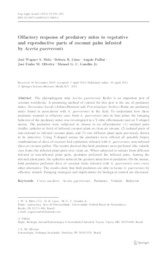Olfactory response of predatory mites to vegetative and reproductive parts of coconut palm infested by Aceria guerreronis.
Olfactory response of predatory mites to vegetative and reproductive parts of coconut palm infested by Aceria guerreronis.
Author(s): MELO, J. W. S.; LIMA, D. B.; PALLINI, A.; OLIVEIRA, J. E. de M.; GONDIM JÚNIOR, M. G. C.
Summary: The phytophagous mite Aceria guerreronis Keifer is an important pest of coconut worldwide. A promising method of control for this pest is the use of predatory mites. Neoseiulus baraki (Athias-Henriot) and Proctolaelaps bickleyi Bram are predatory mites found in association with A. guerreronis in the field. To understand how these predators respond to olfactory cues from A. guerreronis and its host plant, the foraging behavior of the predatory mites was investigated in a Y-tube olfactometer and on T-shaped arenas. The predators were subjected to choose in an olfactometer: (1) isolated parts (leaflet, spikelet or fruit) of infested coconut plant or clean air stream; (2) isolated parts of non-infested or infested coconut plant; and (3) two different plant parts previously shown to be attractive. Using T-shaped arenas the predators were offered all possible binary combinations of discs of coconut fruit epidermis infested with A. guerreronis, non-infested discs or coconut pollen. The results showed that both predators were preferred (the volatile cues from) the infested plant parts over clean air. When subjected to odours from different infested or non-infested plant parts, predators preferred the infested parts. Among the infested plant parts, the spikelets induced the greatest attraction to predators. On the arenas, both predators preferred discs of coconut fruits infested with A. guerreronis over every other alternative. The results show that both predators are able to locate A. guerreronis by olfactory stimuli. Foraging strategies and implications for biological control are discussed.
Publication year: 2011
Types of publication: Journal article
Unit: Embrapa Semi-arid Region
Keywords: Aceria guerreronis, Coco, Cocos Nucifera, Controle Biológico, Coqueiro, Praga, Predadores voláteis, Ácaro
Observation
Some of Embrapa's publications are published as ePub files. To read them, use or download one of the following free software options to your computer or mobile device. Android: Google Play Books; IOS: iBooks; Windows and Linux: Calibre.
Access other publications
Access the Agricultural Research Database (BDPA) to consult Embrapa's full library collection and records.
Visit Embrapa Bookstore to purchase books and other publications sold by Embrapa.

